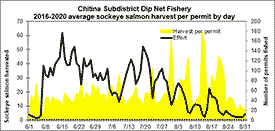Chitina Personal Use Salmon Fishery
Harvest & Effort
Over the last 20 years the department has issued 4,982 – 12,635 permits annually for the Chitina Subdistrict personal use salmon fishery (see table below). About 65% of these permits are actually fished each year. The number of permits issued in this fishery dropped when a $15.00 fee was added in 2017, but the number of permits fished has remained steady.
Generally, more people fish in the beginning of the season when king salmon are present in the fishery (see figures below). Harvest of king salmon is highest early in the season and corresponds with the fishing effort. While king salmon may be present all season, the bulk of the king salmon run is over by mid-July. The wild sockeye salmon run is usually highest in June and then drops off through the season. In late July and early August hatchery fish, bound for the Prince William Sound Aquaculture hatchery on the Gulkana River, provide a boost of salmon into the fishery and account for an average of about 16% of the overall harvest and as much as 75% of the harvest in a given week. Although total harvest is usually highest in June, corresponding with the highest effort, the number of sockeye caught per permit is highest in July and early August.
Harvest in the fishery is most affected by the number of fish running upriver, followed by the number of permits being fished, and finally by water level. Harvest is generally lowest during high water events but can also be low during very low water with a lack of adequate dipping sites. The most productive fishing can be immediately after a high water event, when the fish that have held in the river finally start moving.
Permit holders dipnet from shore or dipnet from boats. Generally, fishing from a boat is more productive since dipnetters can compensate for fluctuating water levels by moving to different locations. However, there are high productive shore fishing sites accessible from the road right-of-way or by drop off from a boat.
| Permits | Harvest | |||||||
|---|---|---|---|---|---|---|---|---|
| Year | Permits Issued |
Permits Fished |
King | Sockeye | Coho | Other | Total harvest |
Harvest per permit fished |
| 1984-1988 | 4,419 | 4,419 | 3,113 | 41,200 | 509 | 34 | 44,026 | 10 |
| 1989-1993 | 6,158 | 6,158 | 3,053 | 75,999 | 1,731 | 48 | 80,852 | 13 |
| 1994-1998 | 8,022 | 7,649 | 4,841 | 110,785 | 2,507 | 31 | 118,194 | 15 |
| 1999-2003 | 8,159 | 6,374 | 3,234 | 109,936 | 2,608 | 260 | 116,039 | 18 |
| 2004-2008 | 8,260 | 5,186 | 2,404 | 112,854 | 2,415 | 504 | 118,177 | 23 |
| 2009-2013 | 8,497 | 5,833 | 671 | 134,537 | 1,535 | 411 | 137,156 | 24 |
| 2014-2018 | 8,377 | 6,074 | 1,278 | 149,889 | 1,783 | 665 | 152,923 | 25 |
| 2019 | 8,071 | 5,467 | 2,689 | 175,413 | 1,088 | 609 | 179,795 | 33 |
| 2020 | 6,810 | 4,466 | 847 | 81,428 | 838 | 230 | 83,343 | 17 |
| Average 2015-2019 | 9,314 | 5,744 | 1,669 | 153,195 | 1,065 | 721 | 156,653 | 27 |
| Average 2010-2019 | 9,808 | 6,017 | 1,221 | 150,663 | 1,248 | 572 | 153,706 | 25 |

Select image to enlarge.

Select image to enlarge.

Select image to enlarge.
When to fish
Watching the sonar counts at Miles Lake can provide an indication of the number of fish moving toward Chitina. It takes 2 – 3 weeks for fish to travel from the sonar site to the Chitina Subdistrict. The sonar counts total salmon and the counts are 95% sockeye salmon. Remember though, just because the sonar says lots of fish should be arriving in Chitina, the fishing may still not be productive. Success can range from epic to terrible with changes in water level that are unpredictable and can occur anytime during the season.
The department has three call-in hotlines (Glennallen: 907-822-5224, Anchorage: 907-267-2511, Fairbanks: 907-459-7382) that are updated at least weekly with sonar passage numbers and times the fishery is open. These hotlines do not provide current river conditions.
